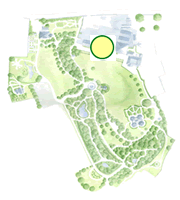Plectranthus scutellarioides (numerous cultivars)
Plant of the month: November
 |
 |
Also known as: Coleus or Solenostemon
Native to: Tropical and subtropical Asia to northern Australia
Blooms: Small, blue flowers not showy; insignificant
Habitat: Margins of tropical rainforest
Where is it found at BBG: Mediterranean House
The famous “coleus” or “painted nettle” has been cultivated in gardens, bedding schemes and conservatories worldwide since Victorian times. It is grown for its popular evergreen, brightly coloured leaves. These leaves can be a single colour or a kaleidoscope of many colour combinations. Plectranthus are easily grown from seed in a warm greenhouse or a sunny windowsill in spring. Named cultivars however must be propagated by cuttings as seed collected from these may revert back to one of the parents and won’t be ‘true’ to type.
New cultivars arise as a natural genetic mutation, showing morphological differences (or different coloured leaves in this case) from the parent plant. These mutations are known as a ‘sport’, ‘break’ or ‘chimera’ in the horticultural industry.
Leaf colours range from green through to yellow, oranges, reds and purples. The small, blue flowers are not as showy as the leaves and should be removed as if they are left on they can cause the plants to lose the lower leaves and detract from the symmetry of the plant. Plants which have been planted outside for the summer must be brought inside or propagated by cuttings in the autumn as they are not hardy.
The genus Plectranthus comes from the Greek words plectron meaning ‘spur’ and anthos meaning ‘flower’. This refers to the spur-shaped flowers of some members of the genus. The specific epithet scutellarioides means Scutellaria-like. Scutellaria is a relative of Plectranthus and is also in the mint or sage family; Lamiaceae.

